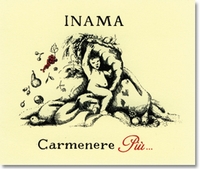Inama, Veneto Rosso IGT (Italy) "Carmenere Più" 2006 (Dalla Terra Winery Direct, $20): The Carmenere grape has emerged from obscurity in recent years because of the number of Carmenere wines available from Chile and the belief that Carmenere can be Chile’s flagship wine, just as Malbec is Argentina’s. I have not espoused that belief, because I’ve found Chile’s Carmeneres as a group inferior to its Cabernets. They often don’t seem to get ripe enough to lose their herbaceous notes. But I have found one Carmenere-based wine that I can enthusiastically endorse. It is from, of all places, northeastern Italy.
in recent years because of the number of Carmenere wines available from Chile and the belief that Carmenere can be Chile’s flagship wine, just as Malbec is Argentina’s. I have not espoused that belief, because I’ve found Chile’s Carmeneres as a group inferior to its Cabernets. They often don’t seem to get ripe enough to lose their herbaceous notes. But I have found one Carmenere-based wine that I can enthusiastically endorse. It is from, of all places, northeastern Italy.
Carmenere, like Malbec, is a variety that was once fairly important in Bordeaux. According to Stefano Inama, who makes this wine, the grape originated on the Dalmatian coast, and it reminds him of vigorous ancient Greek varieties (such as Garganega, the main grape of Soave) more than Bordeaux varieties. Carmenere migrated to northeastern Italy in the 19th century and to Chile. In both locales, it suffered from mistaken identity: The Chileans thought that it was Merlot, and the Italians thought it was Cabernet Franc.
Inama winery is best known as one of the very finest producers of Soave, with prime vineyards in the heart of the classico area. The winery also has vineyards in the hilly Colli Berici DOC zone, east of the Soave area, where it produces several red wines based mainly on Cabernet Sauvignon and Carmenere. Inama began making wine from this area in 1997 using purchased grapes, and in 1999 purchased its first vineyard there, immediately planting Carmenere. The winery has continued acquiring land and now has 30 acres of Carmenere.
This wine’s name, “Carmenere Piu” translates to “Carmenere Plus” because the wine is also 20 to 30% Merlot and 5 to10% Raboso Veronese, a near-extinct local variety.
In its taste, this wine neatly combines the characteristics of Italian red wine (as generalizations go) with the typical characteristics of Carmenere. It is very deep in color, for example, as Carmenere should be, and it has a subtle, low-key aroma, as Italian wines often do. The wine’s acidity is a bit soft for an Italian red, but then it’s a bit high for Carmenere -- a happy compromise.
The wine’s aromas suggest sweet blueberries and dark plums with vanilla, cocoa and black pepper spice; the medium-intense flavors suggest dark fruits, spices and mineral notes. The wine is bone dry and full-bodied with rich, velvety texture that you could even call “fleshy” -- a very unusual descriptor for Italian reds. It has firm but balanced acidity, and a tannin kick on the rear palate, followed by a long finish that echoes the fruity and mineral flavors. One of the impressive aspects of this wine, besides the fact that it has no herbaceous notes whatsoever, is that it is so rich and yet restrained and refined.
This wine aged in French oak barrels for 12 months, but those barrels were one year old, not new. The wine’s tannin -- which the ripe fruit character nicely balances -- seems to reflect the Carmenere grapes at least as much as winemaking technique.
I like this wine in a large Bordeaux-style glass, which brings out its textural richness. It’s very food-friendly, pairing nicely with grilled meats, roasts or dried meats such as salami, and with rich, earthy dishes such as cassoulets. I estimate that it can age nicely for five years.